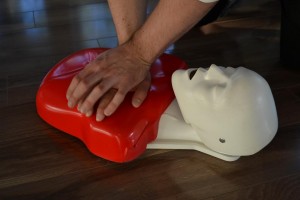CPR is known as cardiopulmonary resuscitation which is a lifesaving procedure carried out to help sustain the function of the brain until medical measures are performed to restore the circulation and breathing. This is usually performed on individuals who are experiencing cardiac arrest. [youtube url=”https://www.youtube.com/watch?v=DfzLNhn0gJk” width=”220″]
Parts of the CPR
There are two parts of CPR – mouth to mouth resuscitation and chest compression. Both help restore the breathing and circulation of the individual. CPR is done by initially pinching the nose of the patient and delivering a blow to his/her mouth. By pinching the individual’s nose using your hand, you will provide a steady flow of air until the chest rises. Deliver two breaths to the individual’s mouth, with each blow lasting about a second.

If the breathing of the individual does not return to normal, it is the time to apply the chest compressions. Push in a firm manner on the part of the chest close to the starting point of the sternum and in the middle of the nipples for 30 times at a fast pace of 2 per second. Continue with this procedure until the medical team arrives on the scene. If two individuals are performing the CPR, one will handle the breathing and the other will work on the compression. The other should pause if the other individual is performing the breathing or pumping. Take note that the procedure is not done at the same time.
When is CPR needed?
It is important that even ordinary individuals should have knowledge of CPR, whether you are a doctor or not. There are situations or emergencies that need CPR right away. There are situations that require immediate attention especially in cases in which someone has inhaled water in a near-drowning incident, inhaled smoke during a fire, cardiac arrest, food poisoning and near-electrocution. Additionally, it can also be administered on cases of (SIDS) sudden infant death syndrome.
When to perform CPR
Before CPR is performed, you have to observe and listen first for signs such as open eyes, movement of arms or legs and sounds being emitted by the person. If none of these are present, try to move or stir the individual to stimulate a reaction. In babies, you have to rub the chest to elicit a response. Perform only 2 minutes of CPR on babies. As for adults and older children, it is best to ask about his/her condition first.
Importance of CPR
- All should master the skills of CPR (cardiopulmonary resuscitation) so that they can handle and manage emergencies which include drowning, choking, electrocution, burns or someone who ceases to breathe. If you will learn CPR, it is the easiest yet the most important skill anyone should learn.
- CPR and first aid techniques are lifesaving measures you have to learn and master because you never know when a situation will occur when CPR might be needed.
- Mastering these skills will prepare you for the actions you find necessary when trying to give someone the chance to survive.
- Being familiar with the steps in delivering CPR will not only help avoid an unexpected situation, but provide measures that can help out an individual.
